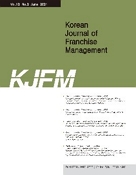 E-ISSN : 2508-4593
E-ISSN : 2508-4593
Vol.14 No.3
Abstract
Purpose: In the post-COVID-19, many consumers still feel uncomfortable with crowding in closed spaces. This study investigates how non-crowding affects consumer satisfaction and restaurant visit intention. Research design, data, and methodology: The data were collected from 350 people aged 20 and above. A total of 347 respondents, excluding 3 unfaithful respondents, were analyzed using Smart PLS 4.0 program. Result: Both spatial and human crowding have significant effects on satisfaction. On the other hand, neither spatial nor human crowding directly affected dine-out intention significantly. In addition, spatial crowding was found to have a direct and significant effect on in-store dining intention, but human crowding did not have a direct and significant effect on in-store dining intention. It was found that satisfaction had a significant effect on both dine-out intention and in-store dining intension. Conclusions: This study has expanded the range of consumer behavioral intentions by applying a non-crowded environment (S) to the SOR theory. Also, Consumer behavioral intention was expanded by dividing visit intention into a dine-out and in-store dining intention. Therefore, we propose measures to minimize human crowding by introducing a system such as adjustment of store operating hours, reservation system, store opening time alarm system, and reduction of cooking time.
Abstract
Purpose: As more and more food franchise companies want to expand overseas, related research is becoming more and more necessary. This study aims to examine the critical factors for successful overseas expansion according to the stages of overseas expansion, derive vital associations, and examine the success factors of overseas expansion through semantic network analysis. Research Design, Data, and Methodology: This study conducted in-depth interviews with three food franchise companies that have experienced overseas expansion and conducted semantic network analysis among crucial associations. The semantic network analysis was conducted using the Textom program. Results: Based on the results of the in-depth interview analysis, the factors considered when expanding overseas were categorized as 1) standardization and localization strategies of overseas franchisees, 2) physical environment of overseas franchisees, 3) entry types of overseas franchisees, 4) constraints of overseas franchisees, and 5) success criteria of overseas franchisees. The semantic network analysis based on the corresponding keywords showed that the importance of local partners is very high in common. Conclusion: This study examined and re-categorized the important factors to consider when a restaurant franchise company expands overseas in a step-by-step manner. In addition, an attempt was made to examine the keywords derived from the semantic network analysis objectively. The results provided theoretical and practical implications for the successful overseas expansion of franchise companies.
Abstract
Purpose: This study is to investigate the causal relationship between franchise headquarters' franchise cost and franchise satisfaction and management performance, and to verify the structural relationship between franchise cost and corporate permanence. Research design, data and methodology: The data were collected from 200 medium-sized franchisees in Seoul and analyzed using confirmatory factor analysis (CFA) to test the validity of the measurement model and the structural equation model (SEM) to identify the impact of franchise costs on corporate performance with the Amos 28.0 program. Result: Franchise costs were found to have a negative effect on franchise satisfaction and corporate permanence. It was confirmed that franchise satisfaction had a significant positive effect on management performance and corporate permanence. Franchise costs had a sequential mediating effect on franchise satisfaction and management performance, which had a significant impact on corporate permanence. Conclusions: This study expanded the theoretical scope by applying the expectation confirmation theory to corporate transactions. In addition, the franchise headquarters proposes ways to create a culture of franchise business with trust by presenting appropriate franchise costs to improve management performance and corporate permanence through franchise satisfaction.
Abstract
Purpose: This study aims to explore the shopping motivations of consumers at South Korean convenience stores and create distinct consumer segments based on these motivations. Additionally, the research seeks to propose tailored marketing strategies for convenience stores by analyzing consumer demographics and satisfaction levels within each segment. Research design, data and methodology: Using factor analysis, we identify three primary shopping motivation factors: "social/leisure," "functional," and "convenience." Subsequently, we use cluster analysis to group convenience store consumers into three categories: the "convenience-seeking group," the "function/convenience-seeking group," and the "multipurpose-seeking group." To gain a deeper understanding of each consumer segment, we investigate how demographic factors relate to their levels of satisfaction. Results: These findings offer valuable insights for adapting to shifting consumer preferences and the increasingly competitive landscape of South Korean convenience stores, especially in the expanding services offered by online businesses. Conclusions: This research emphasizes the significance of developing marketing strategies tailored to address the distinctive needs and preferences of individual consumer segments. These strategies empower convenience stores to establish a competitive advantage in the market.













